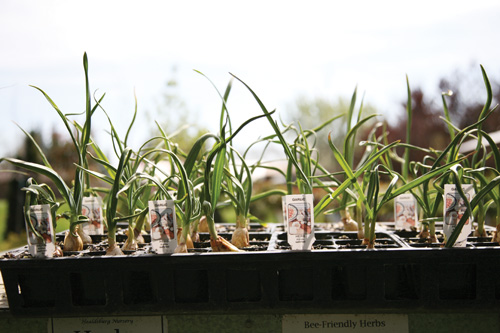The warm weather of February and March has given gardeners planting fever, and a few local farmers are planting out tomatoes in hopes of being the first to bring the precious fruit to market. But is it worth the risk for a backyard gardener to plant summer crops early?
“The Farmers’ Almanac says it’s going to be an early spring, so we’re in for some good stuff,” said Nancy Lyle, garden manager at Garrett Ace Hardware in Healdsburg.
“The farmers have always said April 15 is the planting date, but this year you might try earlier.”
On the other hand, Michael Skurtun, owner of Healdsburg Nursery, urged caution.
“Plant cool weather crops exclusively. It’s still March,” Skurtun said.
What factors into a planting decision? Of course, money and time come into play. Can you afford, financially and logistically, to re-plant tomatoes and peppers if the first ones freeze? Space and the amount of food you hope to grow also affects garden planning. Will you be sacrificing a crop of, say, lettuce or spinach by planting tomatoes early? If your goal is to grow more food in a limited area, you might consider planting greens or radishes to harvest more food before planting summer crops.
However, if your only goal is to get a homegrown, vine-ripened tomato as early as possible, it may be worth the tradeoff — and the risk.
Sometimes, too, the decision boils down to a gut feeling.
“This is the first year that I’ve ever said that, but I’m pretty confident, with the nights warming up, we’ll be fine. I’m looking forward to a great vegetable year,” Lyle said.
Last weekend, some customers were buying dozens of flats of tomato and pepper starts. But others were sticking to traditional spring crops like chard, kale, and onions.
“The soil is still cold, and tomatoes and squash will resent the cold. They go into shock,” Skurtun explained.
He noted that sometimes tomatoes planted later will actually catch up to — and ultimately out-produce — tomatoes planted too early.
“We usually recommend April, May, when the soil is warmer. It all of course depends on weather,” Skurtun said.
Weather is a tricky thing to analyze: what people experience does not accurately reflect what the soil experiences. February felt unseasonably warm to many locals, and the maximum temperature was approximately four degrees higher than average. However, the minimum temperature was four degrees below average, leading to a mean temperature right in line with typical February temperatures.
As of Monday, despite a stretch of balmy days, the mean March temperature was only slightly higher than average due to similar chilly overnight temperatures. But hot days can cause cool weather crops like greens to bolt — so what’s a gardener to do?
Philip Morrison, nursery manager at Harmony Farm Supply, offered a risk-mitigating strategy for customers who are ready to get their hands dirty, but not willing to risk losing their plants.
“Here in our area usually there’s still a chance of frost up until mid April. So if people are buying peppers, tomatoes, usually we’ll tell them to watch the weather… a lot of people will keep them outside during the day, pull them back in at night. Otherwise you can use frost protection: using frost blankets, building hoop tunnels to keep them protected,” Morrison said.
And what if late March brings more 80-degree days?
“If the temperature keeps going up and up, it’s going to be a little tough to really take care of… things like lettuces, broccolis, cauliflowers. Those things might start to bolt really quickly.
It’s kind of shooting the gambit. Hopefully it will stay cool enough that a lot of coastal customers, or folks in shaded areas, can still get away with doing lettuces… but if they are worried about it getting too hot or they’re in a really hot spot in the county, they can put it in a cool spot in their garden, maybe a little bit of shade, so they’re a little bit protected from the heat if we do get a really hot spell that comes through.”
And there are a few things that are safe to plant, no matter what the weather does.
“You can start off with some of the hardier things that can take a little bit of cold as well as heat. Some of your herbs, parsley, cilantros, even getting in rosemaries, lavenders, thymes, all the hardy herb plants are good,” Morrison said.
Whatever the weather may do, one thing is for sure: the warm weather has been good for local nurseries.
“It’s taken off. As appreciative as we are of the early business, we’re cautioning our customers not to get too excited, and to stick to cold weather crops,” Skurtun said. “Just be patient. The soil still needs to warm up.”









